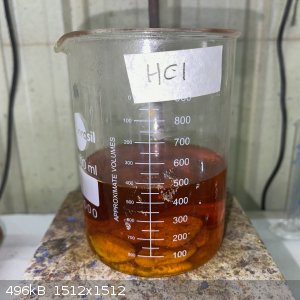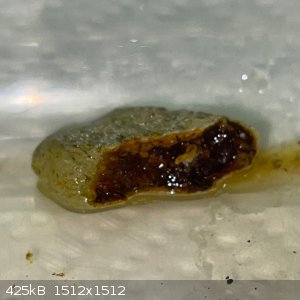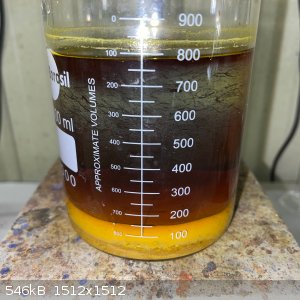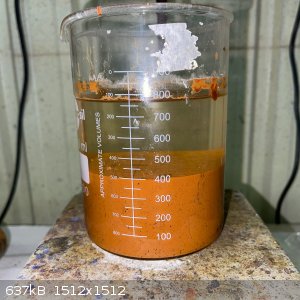Lion850
National Hazard
   
Posts: 517
Registered: 7-10-2019
Location: Australia
Member Is Offline
Mood: Great
|
|
Extracting iron from local rocks
The area where we life is known for its red cliffs. Some beaches are littered with red rocks of all sizes, and we decided to see if we could extract
iron from the rocks. Below shows the area we collected the rocks, and a sample of the washed rocks in a beaker.
 
I thought about crushing the rocks, but they were quite hard so we decided to first work with the rocks whole. My plan was to treat the rocks with
sulphuric acid but as an afterthought I decided to at the same time try nitric acid and hydrochloric acid for comparison.
202g 98% H2SO4, 150ml water, and 104g rocks added to a beaker.
380g 70% HNO3 and 102g rocks added to a beaker.
451g 33% HCl and 101g rocks added to a beaker.
The sulphiric acid, which was very hot due to the mixing with water, did almost nothing. Initially there was some small bubbles, probably from some
carbonate, then nothing. After a few hours the solution was still clear and the rocks appeared the same. This was then discarded.
The nitric acid turned a bit brown quite quick and then stopped changing. The rocks stayed the same. Heating did not seem to make a change. After a
few this was discarded.
The hydrochloric acid kept darkening and seemed to leach the brown color from the rocks. Much more was obviously happening in this beaker. I left this
going.

The next morning I poured off the dark brown liquid and was left with the rocks now having almost completely lost there brown color externally. They
were now much easier to break and inside they were still brown.

I then broke these rocks into small pieces with a large hammer. These pieces went back into the brown solution for a few more days. This was the final
status.

I filtered off the brown solution. The pale green remainder was washed and then dried on a steam bath. I wonder what this is, could it be mainly sand
thus SiO2?

I then started adding sodium hydroxide in 10g portions to the filtrate while stirring. Upon the very first addition some dark solids appeared that did
not re-dissolve in the predominantly HCl solution; I did not expect this. I kept adding NaOH. After adding 95g NaOH, a light brown suspension appeared
but the pH was still under 2. By 125g added the pH was 5, and at 129 added it was 8, and this was where I stopped. At this point there was a lot of
suspension and the beaker was left overnight to settle.

The next morning the clear supernatant liquid was poured off, and the rest put through a vacuum filter. What a pain to filter out....very slow!
Intially the filtrate was very pale brown as some of the fine material seemed to pass through the filter paper but once there was a layer of remainder
the filtrate was clear. The remainder was washed once with water.

The wet remainder was dried on a steam bath, but it dried very slow. It was then placed in a sand bath at maximum hear (should be over 200C). After
some 4 hours there was no more steam being given off, but it was left on for another 2 hours.
The result was a light brown powder. It was very dry and very easy to make dust.
If the sand bath heat was sufficient, I should have ended up with mostly Fe2O3. Below shows a comparison between my light brown product and my
purchased Fe2O3 that is a bit more red.

37g of brown product was recovered. If this is Fe2O3, it equates to some 26g of Fe, thus the iron content of my rocks by weight is some 26%. More than
I would have thought.
The dry product readily completely dissolves on HCl giving the typical iron (iii) brown-slightly red colored solution.
The product dissolved quite easily in strong hot oxalic acid solution; giving a green-ish solution. But there is some decomposition near boil as a gas
is evolved, probably CO2. A green solid can be recovered from this reaction, I assume this is mostly ferric oxalate hydrate (I will revisit making
ferric oxalate to try and get a purer product).
If a suspension of the brown product in water is stirred, it does not stick to the stir bar. However if this suspension is acidified with a few drops
HCl and then a few gram of sodium borohydrate is added, there is s vigorous reaction resulting in a black fine suspension that does stick to the stir
bar. Presumably iron. Adding HCl to this dark sludge gives bubbling off of H2, and it dissolves most of the sludge but not all - there is maybe also
some boron compounds.
I'm still planning to make a few more compounds with my "Fe2O3".
|
|
|
j_sum1
Administrator
       
Posts: 6333
Registered: 4-10-2014
Location: At home
Member Is Offline
Mood: Most of the ducks are in a row
|
|
Where I live, not far from you, the soil is a loose red clay kind of material which contains a high proportion of Fe2O3. I have in the past attempted
to reduce it directly in a thermite reaction. No success. It may be possible, but likely requires sulfur and aluminium as a booster to work.
Thid looks like a good little exercise you have done and it seems you have concentrated the iron quite well.
Use of ferrocyanate, ferricyanate and thiocyanate as indicators may help monitor your process.
|
|
|
Lion850
National Hazard
   
Posts: 517
Registered: 7-10-2019
Location: Australia
Member Is Offline
Mood: Great
|
|
Hi j-sum1 thanks for the reply. I forgot to mention a few things that did not add up. The weight of NaOH I had to add to neutralize the solution and
get the iron out is too high. But most likely my Coles supermarket brand caustic soda contains a lot of water which the stoichiometry does not take
into account. And / or my pool hydrochloric acid is stronger than I assume (I always assume 33%).
I mentioned above that when I initially started adding NaOH a dark solid appeared that stuck to the sides of the beacon and that did not re-dissolve.
When I later decanted the supernatant liquid after the brown suspension settled, I poured the brown remainder into the vacuum filter. But by doing
this carefully I could stop before the apparently much heavier and darker solids mentioned above (only a couple of gram at most) ran out. See photo
below showing the darker sludge with some stains of the light brown being the color of the main product.
And the weird thing is that when I then added HCl to this beaker that now only had this wet dark matter left, it very quickly dissolved into a
brown-red solution! So how could it not have re-dissolved earlier during the neutralization? The only difference being that during the neutralization
there were also more dissolved iron as well as sodium in the medium. Still baffles me.

|
|
|
unionised
International Hazard
    
Posts: 5128
Registered: 1-11-2003
Location: UK
Member Is Offline
Mood: No Mood
|
|
It would be interesting to treat some of the iron oxide with ammonia solution and then filter it again.
The filtrate will contain copper, zinc, nickel etc that were present in the original rock.
If it's colourless, leave it to evaporate and see if there's a solid residue indicating the presence of zinc.
Ay manganese present might have ben concentrated into the first material to precipitate (as MnO2). That's slow to dissolve in dilute HCl.
Do you have access to diethyl ether?
You can extract Fe(III) from a solution in about 20% HCl with ether. (As some complex, typically described as HFeCl4)
Most other metals stay in the aqueous phase.
That's a route to a higher purity iron and also a way to look at what else is in the original rock.
|
|
|
draculic acid69
International Hazard
    
Posts: 1371
Registered: 2-8-2018
Member Is Offline
|
|
Quote: Originally posted by j_sum1  | Where I live, not far from you, the soil is a loose red clay kind of material which contains a high proportion of Fe2O3. I have in the past attempted
to reduce it directly in a thermite reaction. No success. It may be possible, but likely requires sulfur and aluminium as a booster to work.
Thid looks like a good little exercise you have done and it seems you have concentrated the iron quite well.
Use of ferrocyanate, ferricyanate and thiocyanate as indicators may help monitor your process. |
I think red soil is only around 6% fe2o3. I'm guessing that a bit of enrichment first
like getting rid of sand and clay would potentially help get you a result. If you google red soil the Wikipedia has a %composition.great idea though.
Why go through all the steps of extraction if U can just thermite straight to metal. It would have been beautiful if it worked.
|
|
|
draculic acid69
International Hazard
    
Posts: 1371
Registered: 2-8-2018
Member Is Offline
|
|
Quote: Originally posted by Lion850  | Hi j-sum1 thanks for the reply. I forgot to mention a few things that did not add up. The weight of NaOH I had to add to neutralize the solution and
get the iron out is too high. But most likely my Coles supermarket brand caustic soda contains a lot of water which the stoichiometry does not take
into account. And / or my pool hydrochloric acid is stronger than I assume (I always assume 33%).
I mentioned above that when I initially started adding NaOH a dark solid appeared that stuck to the sides of the beacon and that did not re-dissolve.
When I later decanted the supernatant liquid after the brown suspension settled, I poured the brown remainder into the vacuum filter. But by doing
this carefully I could stop before the apparently much heavier and darker solids mentioned above (only a couple of gram at most) ran out. See photo
below showing the darker sludge with some stains of the light brown being the color of the main product.
And the weird thing is that when I then added HCl to this beaker that now only had this wet dark matter left, it very quickly dissolved into a
brown-red solution! So how could it not have re-dissolved earlier during the neutralization? The only difference being that during the neutralization
there were also more dissolved iron as well as sodium in the medium. Still baffles me.
|
This is very interesting and something I might try one day.
Excellent write-up
|
|
|
Bezaleel
Hazard to Others
  
Posts: 444
Registered: 28-2-2009
Member Is Offline
Mood: transitional
|
|
Quote: Originally posted by Lion850  |
The next morning the clear supernatant liquid was poured off, and the rest put through a vacuum filter. What a pain to filter out....very slow!
|
That sounds familiar. I had the same experience filtering precipitated iron from an impure Mohr's Salt solution. It took literally 2 hours to filter
on a fine fritte at around 5 mBar vacuum. A coarse fritte would just let everything run through.
|
|
|